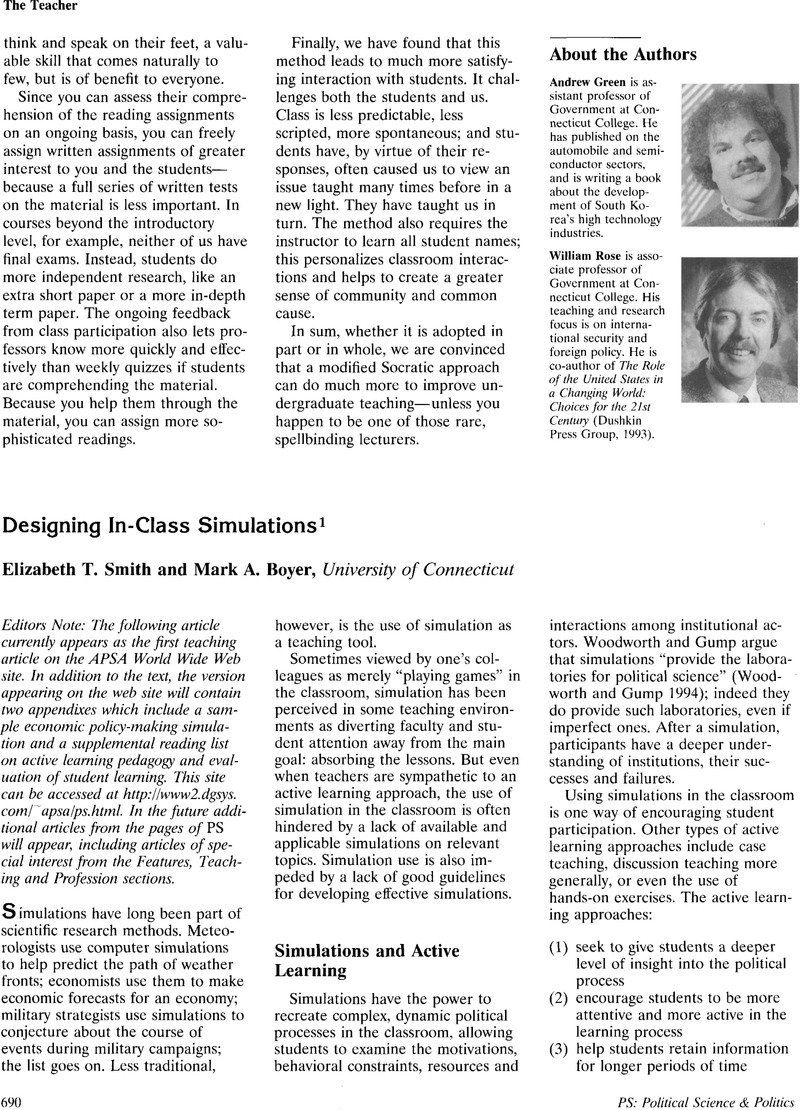Crossref Citations
This article has been cited by the following publications. This list is generated based on data provided by Crossref.
Chapman, Kenneth J.
and
Sorge, Christine L.
1999.
Can a Simulation Help Achieve Course Objectives? An Exploratory Study Investigating Differences Among Instructional Tools.
Journal of Education for Business,
Vol. 74,
Issue. 4,
p.
225.
Brock, Kathy L.
and
Cameron, Beverly J.
1999.
Enlivening Political Science Courses with Kolb's Learning Preference Model.
PS: Political Science & Politics,
Vol. 32,
Issue. 2,
p.
251.
Josefson, Jim
and
Casey, Kelly
2000.
Simulating Issue Networks in Small Classes Using the World Wide Web.
PS: Political Science & Politics,
Vol. 33,
Issue. 4,
p.
843.
Bernstein, Jeffrey L.
Scheerhorn, Sarah
and
Ritter, Sara
2002.
Using Simulations and Collaborative Teaching to Enhance Introductory Courses.
College Teaching,
Vol. 50,
Issue. 1,
p.
9.
Roper *, Steven D.
2004.
Teaching students how to be revolutionaries or reformers: a course simulation.
Innovations in Education and Teaching International,
Vol. 41,
Issue. 3,
p.
245.
Smith, Claire
and
Burke, Heather
2005.
Becoming Binford: Fun ways of teaching archaeological theory and method.
Public Archaeology,
Vol. 4,
Issue. 1,
p.
35.
Thies, Cameron G.
2005.
How to Make the Most of Your Summer Study Abroad Teaching Experience.
PS: Political Science & Politics,
Vol. 38,
Issue. 1,
p.
83.
Stover, William James
2005.
Teaching and Learning Empathy: An Interactive, Online Diplomatic Simulation of Middle East Conflict.
Journal of Political Science Education,
Vol. 1,
Issue. 2,
p.
207.
Frederking, Brian
2005.
Simulations and Student Learning.
Journal of Political Science Education,
Vol. 1,
Issue. 3,
p.
385.
Williams, Victoria C.
2006.
Assuming Identities, Enhancing Understanding: Applying Active Learning Principles to Research Projects.
Journal of Political Science Education,
Vol. 2,
Issue. 2,
p.
171.
Galatas, Steven E.
2006.
A Simulation of the Council of the European Union:
Assessment of the Impact on Student Learning.
PS: Political Science & Politics,
Vol. 39,
Issue. 1,
p.
147.
KRAIN, MATTHEW
and
LANTIS, JEFFREY S.
2006.
Building Knowledge? Evaluating the Effectiveness of the Global Problems Summit Simulation.
International Studies Perspectives,
Vol. 7,
Issue. 4,
p.
395.
Shellman, Stephen M.
and
Turan, Kürşad
2006.
Do Simulations Enhance Student Learning? An Empirical Evaluation of an IR Simulation.
Journal of Political Science Education,
Vol. 2,
Issue. 1,
p.
19.
Baranowski, Michael
2006.
Single Session Simulations: The Effectiveness of Short Congressional Simulations in Introductory American Government Classes.
Journal of Political Science Education,
Vol. 2,
Issue. 1,
p.
33.
Oros, Andrew L.
2007.
Let's Debate: Active Learning Encourages Student Participation and Critical Thinking.
Journal of Political Science Education,
Vol. 3,
Issue. 3,
p.
293.
DeLeon, Abraham P.
2008.
Are We Simulating the Status Quo? Ideology and Social Studies Simulations.
Theory & Research in Social Education,
Vol. 36,
Issue. 3,
p.
256.
Rivera, Sharon Werning
and
Simons, Janet Thomas
2008.
Engaging Students Through Extended Simulations.
Journal of Political Science Education,
Vol. 4,
Issue. 3,
p.
298.
Kiasatpour, Soleiman
and
Whitfield, Christopher
2008.
Politics in Action: Wolves, Snowmobiles, and Bison and
the Greater Yellowstone Ecosystem.
PS: Political Science &
Politics,
Vol. 41,
Issue. 1,
p.
193.
Bernstein, Jeffrey L.
2008.
Cultivating Civic Competence: Simulations and Skill-Building in an Introductory Government Class.
Journal of Political Science Education,
Vol. 4,
Issue. 1,
p.
1.
Kelle, Alexander
2008.
Experiential Learning in an Arms Control
Simulation.
PS: Political Science &
Politics,
Vol. 41,
Issue. 2,
p.
379.





